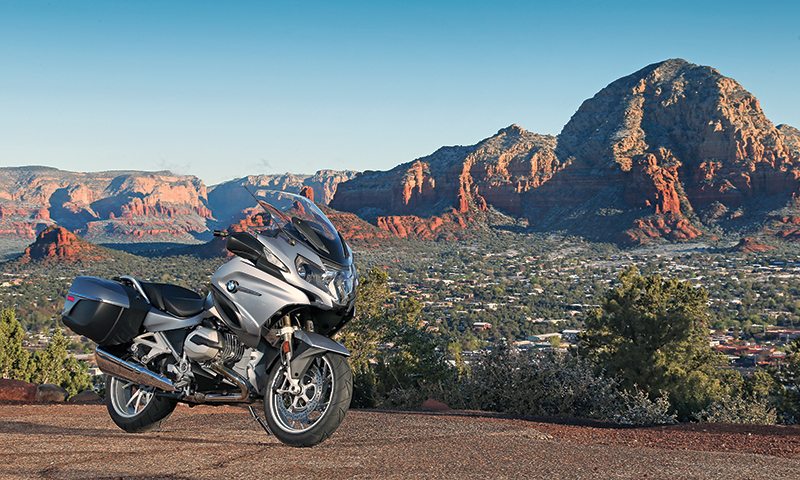
Sport-touring bikes have a love/hate relationship with weight. A rider generally moves up to a sport tourer in order to get creature comforts such as a full fairing, electric windscreen, integrated saddlebags and more fuel capacity. On the other hand, the extra pounds these niceties pile on can take a toll on the bike’s handling, acceleration, stopping distances and maneuverability at low speeds, the very stuff that puts the “sport” in sport touring. “Road-hugging weight” may have been a good thing in the ’70s Ford Pinto, but if you want to make a motorcycle faster, handle better and stop quicker, you gotta add lightness.
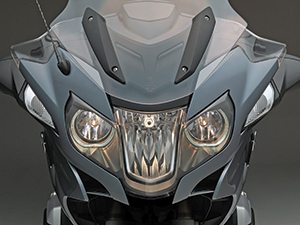
BMW’s R 1200 RT sport tourer has always enjoyed an advantage in the weight department, thanks mostly to having a compact twin-cylinder engine vs. the big multis in the competition. In our last five-bike sport-touring shootout (Rider, May 2013), at 626 pounds wet the RT undercut the next heaviest bike (Yamaha FJR1300) by 37 pounds, and the heaviest (BMW K 1600 GT) by a whopping 131. Despite being the least powerful of the bunch, it still came in second overall, testament to its functional blend of nimble handling, comfort and convenience, if not performance. The 2013 and earlier models are nice-looking motorcycles, too, all good things…especially since so many of them are going to be coming on the used market soon.
You can thank the desirability of the new RT for that. For 2014, BMW has completely revamped its core touring bike, starting with the lighter, liquid-cooled engine from the R 1200 GS. This is wrapped in a stiffer new frame with vastly improved suspension, ergonomics, all-new bodywork and state-of-the-art electronics. It’s a fresh, modern reset that brings the bike even with the class-leading K 1600 models in technology, and closer to the competition in power potential.
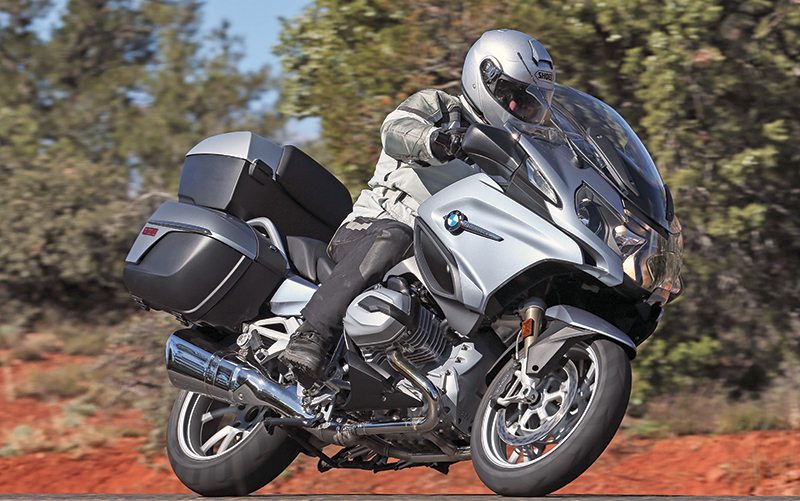
We covered the new engine in detail in our tests of the first bike to get it, the 2013 R 1200 GS (April and September 2013). In sum, by using precision liquid cooling for the hottest areas in the DOHC opposed flat twin, BMW was able to position the valve pairs horizontally, with the exhaust valves on the bottom and intakes and larger downdraft throttle bodies up top, creating a more efficient vertical intake path and more room for the rider’s legs. Better cylinder filling eliminated the need for two spark plugs, compression went up to 12.5:1 and throttle-by-wire brings a host of good things—cruise control, riding modes switchable on the fly, automatic throttle body synchronization—even less throttle effort and twist angle. A new wet slipper clutch and oil-cooled alternator replace the clanky dry clutch and bulky external alternator, and the gearbox is integrated into the engine cases too, all helping to make the engine much more compact. Add a counterbalancer shaft and higher redline of 9,000 rpm and you have the recipe for less weight and vibration and more power.
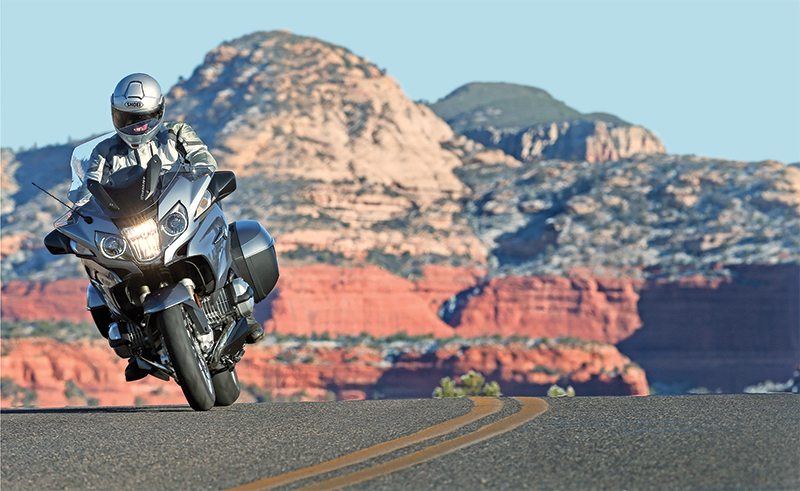
The new more rev-happy engine is a little less luggable down low in the GS, so BMW added some weight to the alternator and crankshaft journals—about two pounds—in the R 1200 GS Adventure and R 1200 RT to increase the engine’s flywheel effect. Rotating inertia is up about 20 percent, which makes the RT and GSA smoother and improves their tractability quite noticeably at low speeds. On the RT, the benefits are reaped throughout the powerband, as it makes the bike smoother overall, easier to ride at low speeds two-up and accelerate more smoothly out of corners. The RT’s secondary gear ratio is a little lower as well, to reduce rpm at cruising speeds.
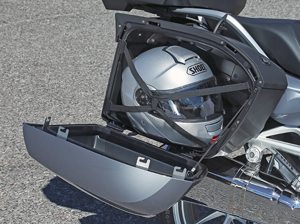
On the Jett Tuning dyno, the 2014 R 1200 RT cranked out an impressive 114.6 horsepower at 7,900 rpm at the rear wheel, 15 more than our 2013 test bike and even a couple more than our 2013 GS. Torque is up 9 lb-ft to 82.7 at 6,400 rpm, and the torque curve is flatter and stays above 72 lb-ft from 3,400 rpm to 8,200 rpm. It’s still a few ponies shy of equaling the next sport tourer up the power ladder, the Triumph Trophy triple. But the 2014 R 1200 RT is three pounds lighter than our 2013 test bike, and has several additional features such as Dynamic ESA and central locking, not to mention a pair of radiators hidden in that swoopy new fairing.
While the revised engine is the star, the RT’s new tubular-steel continuous bridge frame is the unsung hero of this revamp. In addition to being stiffer overall, it provides stouter mounting locations for the front Telelever and rear Paralever suspension swingarms for better handling, and it’s narrower in the rider’s leg area, allowing a more comfortable seating position and easier reach to the ground. The bike’s handlebars and footpegs are lower, and the rider and passenger seats are lower and longer, so the bike is easier to manage at a stop and the riders have more space. Overall, the bike is even more agreeable on long rides than its predecessor, upon which my wife Genie and I have covered tens of thousands of miles in complete comfort.
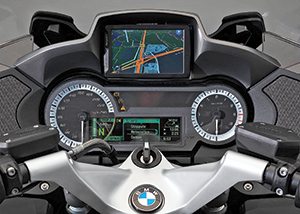
The ergonomic changes are complemented with a quieter, more aerodynamic electric windscreen with the same generous adjustment and coverage as before. Clear deflectors on either side and new mirrors provide protection for the hands, and the mirrors fold inward a couple inches now for transport or tight parking. Both high and low no-cost optional seats are available for the RT, and the low one sits at just 29.9 inches in the lowest position, eliminating the need for the former low-suspension option. Overall, the RT’s focus on rider comfort and protection surpasses most motorcycles, even some defined as luxury tourers, yet it still feels light, sporty and ready to play.
New options and equipment abound on the 2014 RT. The base model is nicely equipped, but most riders will at least opt for the Standard Package, which adds cruise control, a second accessory socket and GPS preparation. The high level of integration among the GPS, bike and handlebar Multi-Controller ring makes the GPS Prep a serious consideration, since it requires a factory mount and can’t be added later.
Same goes for the new Dynamic Electronic Suspension Adjustment (ESA) in the Touring Package. New position sensors on the front and rear suspension have made the ESA semi-active, or “Dynamic,” so that it maintains the bike’s attitude and aids directional stability by constantly adjusting damping based upon the suspension position, travel and speed of
vertical movement, as well as throttle action and brake information. This intervention is tough to sense at the handlebars, but suffice to say the Dynamic ESA is always compliant and controlled no matter how it’s set, and works seamlessly in the background. The ESA automatically changes the damping settings to Hard, Normal or Soft to correspond with the rider’s selection of Dynamic, Road and Rain riding modes, or the rider can adjust the damping settings manually on the fly. The system is considered “semi”-active because the rider still selects the bike’s rear spring preload setting (at a stop with the engine running).
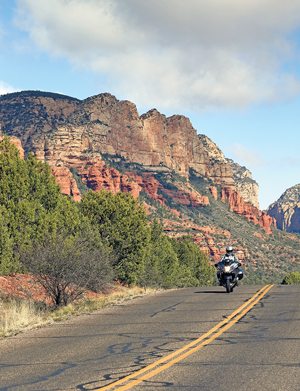
Some other new options are easier to live without, such as the new Hill Start function, which holds the bike at a stop on a hill until you start out. I can imagine a few scenarios where this might be helpful, but can’t remember ever really needing it. There’s also Gear Shift Assist Pro, which eliminates the need to use the clutch lever, or even roll-off the throttle, to upshift, and allows downshifting without the clutch when the throttle is closed. It does have an advantage over other automatics in that it retains the clutch lever for low-speed maneuvers, and is nice to have at times, but I often forgot it was there.
We put nearly 1,500 miles on our fully loaded R 1200 RT on every imaginable kind of road, both solo and two-up, in the rain, snow flurries and temperatures ranging from 27 degrees to 99, and loved every minute. Except for a little bit of driveline lash and gearbox noise at times, it’s really hard to find fault with this motorcycle. It’s plenty fast for all-day high-speed riding, charging around in the canyons and brisk passes on the highway, even two-up and fully loaded, yet still possesses the tight-turning capability and engine tractability that have made it a mountain goat on tight passes in the Alps. Suspension compliance, braking power and ABS performance are unrivaled, and though it handles a tiny bit less quickly than before, it still carves a corner like a much smaller sportbike. I was the only test rider bothered by the bike’s tendency to hunt slightly on the highway at speed, a trait I found less prevalent on an identical machine wearing Michelin Pilot Road 4 tires instead of the Contis on our test bike.
Many new standard and optional features update the RT to the same technological status as the flagship K 1600s. The new tiltable 5.7-inch TFT color instrument display is information central, with a complete menu system controlled by the Multi-Controller. This is where you change all of the bike’s settings—suspension, traction control, grip and seat heating, audio modes, navigation—and access the extensive trip computer information. Changing riding modes is still done with a separate button on the right grip. We do love the menacing look of the new headlight setup, with round high beams flanking the elongated low beam (surprisingly all halogen instead of LED like the taillight and turn signals—those LED corona rings are optional), and have come to appreciate the foofy stuff like central locking and heated seats. The optional audio system has speakers with new bass tube woofers and incorporates more functions into the Multi-Controller to pare the buttons down on the fairing from eight to four. It also offers USB input, XM/Sirius satellite radio and Bluetooth, so you can pair it with a phone and BT headsets. The standard side cases easily hold a full-face helmet and are more aerodynamic, and both fairing pockets lock with the central locking option.
One bike to rule them all? Lacking the off-road capability of the R 1200 GS/A, the R 1200 RT isn’t quite BMW’s Swiss Army knife of motorcycles, but if you’re not going to ride in the dirt the R 1200 RT does just about everything else, and does it really well. It’s the Light Heavyweight of the sport-touring world.
2014 BMW R 1200 RT
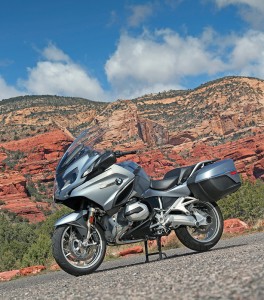
Base Price: $17,650
Price as Tested: $21,725 (Premium Package, Gear Shift Assist Pro, Central Locking)
Warranty: 3 yrs., 36,000 miles
Website: bmwmotorcycles.com
Engine
Type: Liquid-cooled, longitudinal flat opposed twin
Displacement: 1,170cc
Bore x Stroke: 101.0 x 73.0mm
Compression Ratio: 12.5:1
Valve Train: DOHC, 4 valves per cyl.
Valve Insp. Interval: 6,000 miles
Fuel Delivery: BMS-X EFI
Lubrication System: Wet sump, 4.2-qt. cap.
Transmission: 6-speed, hydraulically actuated wet clutch
Final Drive: Shaft, 2.91:1
Electrical
Ignition: Digital electronic
Charging Output: 540 watts max.
Battery: 12V 16AH
Chassis
Frame: Tubular-steel bridge frame w/ engine as stressed member & Paralever cast aluminum single-sided swingarm
Wheelbase: 58.5 in.
Rake/Trail: 26.4 degrees/4.6 in.
Seat Height: 31.7/32.5 in.
Suspension, Front: Telelever w/ single shock, Dynamic ESA & 4.7-in. travel
Rear: Single shock w/ Dynamic ESA & 5.4-in. travel
Brakes, Front: Dual discs w/ 320mm floating rotors, opposed 4-piston calipers & Integral ABS
Rear: Single disc w/ 276mm rotor, 2-piston floating caliper & ABS
Wheels, Front: Cast, 3.5 x 17 in.
Rear: Cast, 5.5 x 17 in.
Tires, Front: 120/70-ZR17
Rear: 180/55-ZR17
Wet Weight: 623 lbs. (as tested)
Load Capacity: 468 lbs. (as tested)
GVWR: 1,089 lbs.
Performance
Fuel Capacity: 6.6 gals., last 1.3 gal. warning light on
MPG: 89 PON min. (low/avg/high) 42.7/44.2/46.8
Estimated Range: 292 miles
Indicated RPM at 60 MPH: 3,300
(This article Light Heavyweight was published in the July 2014 issue of Rider magazine.)

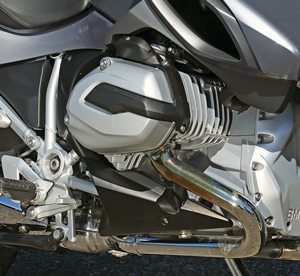
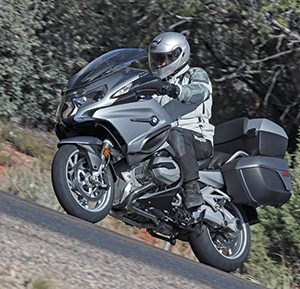

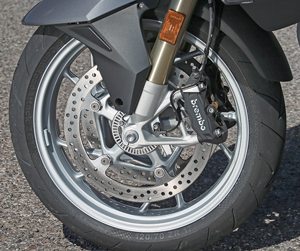








I just got my new R1200RT in October and only have 1,800 miles on it. It’s the same color as the article and equipped with all the same options. It’s my second BMW after having a K1200LT. The R1200RT is an awesome and impressive motorcycle. We chose it over the K1600GTL.
I’m torn between new RT and Triumph’s Trophy. I value reliability and durability and have had K1200s and 1300S. Great bikes but unreliable so I’m confused as I think I’m just about old enough at 64 to try a boxer engine but would like to avoid K series reliability issues. Any advice very welcome.
Curious..what issues did you have with your K bikes. My experience on a 2006 K12S….and that of several other K12/K13 owners.. the bike has been flawless. I have nearly 60,000 miles on mine. Great sport touring bike.
Curious..what issues did you have with your K bikes.
My experience on a 2006 K12S….and that of several other K12/K13 owners.. the bike has been flawless. I have nearly 60,000 miles on mine. Great sport touring bike.
Go with the Trophy! Still new leftover 2014 TTSEs currently can be had for enormous dealer discounts. The new all black color for 2015 is an absolutely beautiful motorcycle!